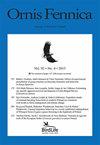波兰混合鹭园中大白鹭(Ardea alba)和灰鹭(A. cinerea)的生产力以及雏鸟对无人机的行为反应
IF 1
4区 生物学
Q2 ORNITHOLOGY
引用次数: 0
摘要
鸟类种群的生产力提供了重要的人口信息,有助于了解种群动态和物种扩张过程。我们测试了这样一个假设:在混合鹭园中共同繁殖的两种生态相似的鹭类的生产力与它们的扩张状况有关。我们预计,在新区域定居且数量不断增加的扩张物种的表现会优于数量稳定的本地物种。2018 年,我们研究了波兰东部混合群落中两种苍鹭的繁殖成功率:大白鹭(Ardea alba)(扩张性物种,繁殖范围和种群规模不断扩大)和灰鹭(Ardea cinerea)(本地物种,繁殖种群稳定)。大白鹭和灰鹭的平均生产力(每巢幼鸟数量)相似,在混合鹭园中似乎相互关联。这两个物种的生产力与鹭群大小无关,但灰鹭的生产力往往随着鹭群中大白鹭巢比例的增加而提高。灰鹭和大白鹭的生产率相近的原因是食物资源充足,竞争程度低。这两个物种的幼鸟对接近的无人机的反应有显著差异:大白鹭幼鸟采取直立展示的平均概率为 0.47,而灰鹭幼鸟仅为 0.18(P=0.025)。这不太可能是与年龄有关的差异,因为两个物种的雏鸟处于相似的发育阶段,但可能代表了某种物种特有的特征。我们的研究再次表明,无人机可以快速、非侵入性地研究苍鹭、白鹭和其他涉禽的繁殖数量和繁殖性能。本文章由计算机程序翻译,如有差异,请以英文原文为准。
Productivity of the Great Egret (Ardea alba) and Grey Heron (A. cinerea) in mixed heronries in Poland and behavioral response of fledglings to a drone
Productivity of avian populations provides important demographic information helpful in understanding population dynamics and processes involved during species expansions. We tested the hypothesis that the productivity of the two species of ecologically similar herons that breed together in mixed heronries is related to their expansion status. We expected the expansive species, colonizing the new area and increasing in numbers, to outperform the native species, whose abundance is stable. We studied the breeding success of two herons in mixed colonies in eastern Poland in 2018: Great Egret (Ardea alba) (an expansive species, increasing breeding range and population size), and the Grey Heron (Ardea cinerea) (a native species, stable breeding population). Mean productivity (number of young per nest) was similar for Great Egret and Grey Heron and appeared correlated to each other in mixed heronries. Productivity of both species was unrelated to the colony size, but Grey Heron tended to have higher productivity as the proportion of Great Egret nests in the colony increased. Similar productivity of both species can be explained by the sufficient food resources coupled with the low level of competition. The two species differed significantly in their response of young to the approaching drone: the mean probability of a young Great Egret adopting an upright display was 0.47 compared to only 0.18 in a young Grey Heron (P=0.025). This was unlikely an age-related difference as the fledglings of both species were at a similar stage of development, but may represent some kind of a species-specific trait. Our research once again shows that UAVs allow a quick and non-invasive study of the size of the breeding populations and reproductive performance of herons, egrets and other wading birds.
求助全文
通过发布文献求助,成功后即可免费获取论文全文。
去求助
来源期刊

Ornis Fennica
生物-鸟类学
CiteScore
2.00
自引率
0.00%
发文量
14
审稿时长
>12 weeks
期刊介绍:
Ornis Fennica is a peer-reviewed international ornithological journal published by BirdLife Finland. Ornis Fennica publishes analytical and experimental papers on the ecology, behaviour and biogeography of birds. Ornis Fennica prefers studies concerning Fennoscandian species, but other novel contributions of general interest are most welcome as well.
Ornis Fennica is an open-access journal without page charges for publication. All published articles (from 1924 onwards) are freely available from the journal website. First decisions are usually made within three months of submission.
 求助内容:
求助内容: 应助结果提醒方式:
应助结果提醒方式:


